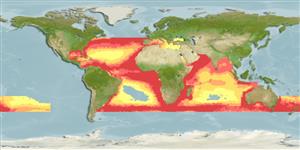Classification / Names
Common names from other countries
Main reference
Size / Weight / Age
Max length : 130 cm TL male/unsexed; (Ref. 11441); common length : 60.0 cm TL male/unsexed; (Ref. 3482); max. published weight: 14.4 kg (Ref. 4699); max. reported age: 9 years (Ref. 6845)
Length at first maturity
Lm 30.0 range ? - ? cm
Environment
Marine; brackish; pelagic-oceanic; oceanodromous (Ref. 51243); depth range 0 - 200 m (Ref. 54708)
Climate / Range
Subtropical, preferred 26°C (Ref. 107945); 45°N - 44°S, 180°W - 180°E
Distribution
Circumglobal: In tropical to subtropical waters; except the eastern Pacific (Ref. 33390). Eastern Atlantic: Portugal to South Africa, including the Mediterranean and Black Sea, Madeira, and the Canary Islands. Western Atlantic: Canada and Bermuda to Argentina (Ref. 7251). Indian Ocean: along the coast of East Africa, Madagascar, southern Oman, southwest India, the Malay Peninsula, and Western Australia (Ref. 11441). Southwest Pacific: Australia except the Northern Territory, and New Zealand (Ref. 11441). Absent from eastern Pacific and northwest Pacific. Barely entering the Western Central Pacific region. Records from the Northern Territory, Australia and from Indonesia appear to be erroneous (Ref. 9860). Occurrence in Taiwan (Ref. 5193) and Hawaii (Ref. 4517) need verification.
Countries | FAO areas | Ecosystems | Occurrences | Introductions
Short description
Dorsal
spines
(total): 8 - 9;
Dorsal
soft rays
(total): 23-28;
Anal
spines: 2-3;
Anal
soft rays: 23 - 27. Jaw teeth prominent, sharp, compressed, in a single series. Two dorsal fins, the first short and low, with 7 or 8 feeble spines connected by a membrane. Back greenish, sides and belly silvery (Ref. 9860).
IUCN Red List Status (Ref. 115185)
Threat to humans
Traumatogenic (Ref. 27695)
Human uses
Fisheries: highly commercial; aquaculture: commercial; gamefish: yes; bait: usually
Tools
Special reports
Download XML
Internet sources
Estimates of some properties based on models
Phylogenetic diversity index
PD50 = 1.5000 many relatives (e.g. carps) 0.5 - 2.0 few relatives (e.g. lungfishes)
Trophic Level
4.5 ±0.3 se; Based on diet studies.
Resilience
Medium, minimum population doubling time 1.4 - 4.4 years (K=0.10-0.2; tm=2; tmax=9; Fec=1 million)
Vulnerability
High vulnerability (63 of 100)
Price category
